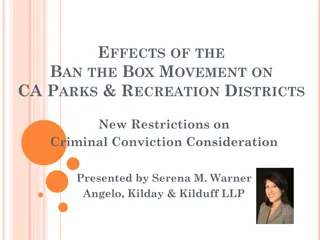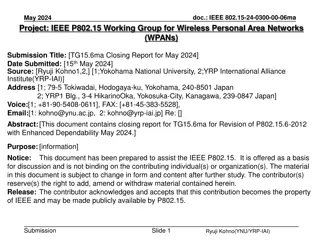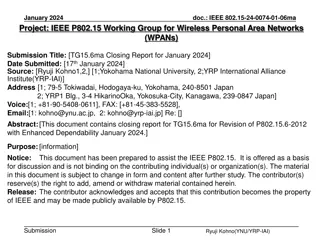
Understanding Customer Relationship Management (CRM) for Business Success
Customer Relationship Management (CRM) is a vital business strategy focusing on managing interactions with customers to enhance relationships, increase customer lifetime value, and drive profitability. Learn about the definition, purpose, stages, and importance of CRM in this comprehensive guide. Discover how CRM helps businesses retain customers, reduce costs, and improve products or services to achieve long-term success.
Download Presentation

Please find below an Image/Link to download the presentation.
The content on the website is provided AS IS for your information and personal use only. It may not be sold, licensed, or shared on other websites without obtaining consent from the author. If you encounter any issues during the download, it is possible that the publisher has removed the file from their server.
You are allowed to download the files provided on this website for personal or commercial use, subject to the condition that they are used lawfully. All files are the property of their respective owners.
The content on the website is provided AS IS for your information and personal use only. It may not be sold, licensed, or shared on other websites without obtaining consent from the author.
E N D
Presentation Transcript
CRM CUSTOMER RELATIONSHIP MANAGEMENT A.AYESHA SIDDIQUA, M.Com., M.Phil., SET, Ph.D.,
What is CRM CRM Customer relationship management (CRM) is a model for managing a company s interactions with current and future customers. It involves using technology to organize, automate, and synchronize sales, marketing, customer service, and technical support. CRM is a business strategy that aims to understand, predict and manage the needs of an organisation s currentand potential customers
Definition of CRM CRM is concerned with the creation, development and enhancement of relationships with carefully targeted customers and customer groups resulting in maximizing their total customer life-timevalue . individualised customer
The purpose of CRM Helpa business to keepcustomers. It helps the business to understand what it needs to do toget morecustomers. Reduce costs by managing costly complaints and finding outwhatservices are useless forcustomers. Help a company figure out if its product is working and, ultimately, increases profit. Prime reason is to log and manage customer relationships.
Stages of Customer Relationship Visitor - The online CRM is the entry portal to your company, however the visitor finds you. Whether they visit with your representatives at a trade show, or fill out a web form, they enter the front door of your virtual company and into the online CRM to be greeted with a welcome and offered something valuable to them. WARNING: Do not skip this importantstageoryouremails may be rejected later. Engaged Visitor - online CRM is able to engage the sales lead and rescue your sales. The first place you engage the visitor is in the welcome email. Be gracious and welcoming.
Prospect In some companies, just clicking on the link to the first offer will convert the sales lead into a prospect. It may be time to have your salespeople call to offer help and guide the sale. Whatever the sales process for your product or service, an email campaign delivered in your online CRM is the most engaging and personal way to get them to pay attention toyour message. Customer Way too many companies stop courting the business after they have become a customer. Some feel that customers are not loyal anyway, so what s the point? Others believe that if they concentrate their effort on delivering good products and excellent service it will be enough to earn whatever loyalty is possible.
Advocate In an online world where customers can post their experience with your company to be seen by anyone who may be interested customers have the enviable power to make or break demonstrated by such companies as Apple, Amazon and more, devout loyalty is possible when customers feel important. They feel deeply attached to the companies who make them feel valued and heard. your business. As
Relationship Marketing Relationship marketing was first defined as a form of marketing developed from direct response marketing campaign which emphasizes customer retention and satisfaction, rather than a dominant focus on sales transactions. Marketing activities that are aimed at developing and managing trusting and long-term relationships with larger customers. In relationship marketing, customer profile, buying patterns, and history of contacts are maintained in a sales database, and an account executive is assigned to one or more major customers to fulfill their needs and maintain the relationship.
Purpose of relationship marketing Satisfaction Today s customers face a growing range of choices in the products and services they can buy . They are making their choice on the basis of their perceptions of quality, service, and value. Companies need to understand the determinants of customervalue and satisfaction. Retention To create customer satisfaction, companies must manage their value chain as well as the whole value delivery system in a customer-centered way. The company s goal is not only to get customers, but even more importantly to retain customers. Customer relationship marketing provides the key to retaining customers and involves providing financial and social benefits as well as structural ties to the customers. Companies must decide how much relationship marketing to invest in different market segments and individual customers, from such levels as basic, reactive, accountable, proactive, and full partnership
Types of CRM Nowadays, management systems, namely operational CRM, analytical CRM and collaborative CRM are being used in manyorganizations. three major types of customer relationship Operational CRM It provides support to front-office business processes that involve direct interaction with customers through any communication channel, such as phone, fax, e-mail, etc. The details of every interaction with customers, including their requirements, preferences, topics of discussion etc., are stored in the customers contact history and can be retrieved by the organization s staff whenever required. Thus, it presents a unified view of customers across the organization and across all communication channels. Examples applications are sales force automation (SFA), customer service and support (CSS), enterprise marketing automation (EMA),etc. of operational CRM
Analytical CRM It enables to analyze customer data generated by operational CRM applications, customers behavior, and derive their true value to the organization. This helps to approach the customers with related information and proposals that satisfy their needs. The analytical customer relationship management applications use analytical marketing tools like data mining information like the buying patterns of the customers, target market, profitable and unprofitable customers, etc., that help to improve performanceof the business. understand the to extract meaningful
Collaborative CRM It allows suppliers, and business partners and, thus, enhances sales and customer services across all the marketing channels. The major goal of collaborative customer relationship management applications is to improve the quality of services provided to the customers, thereby increasing the customers loyalty. Examples of collaborative CRM applications relationship management serviceand feedback, etc. easier collaboration with customers, are partner self- (PRM), customer






















